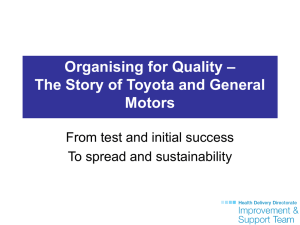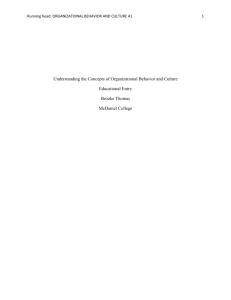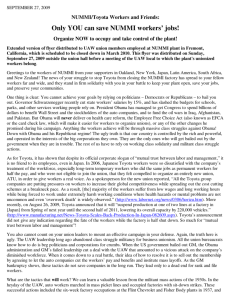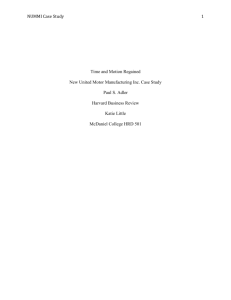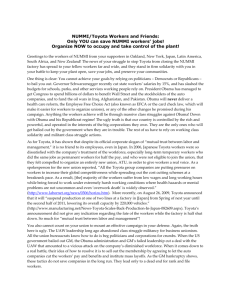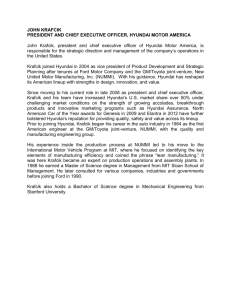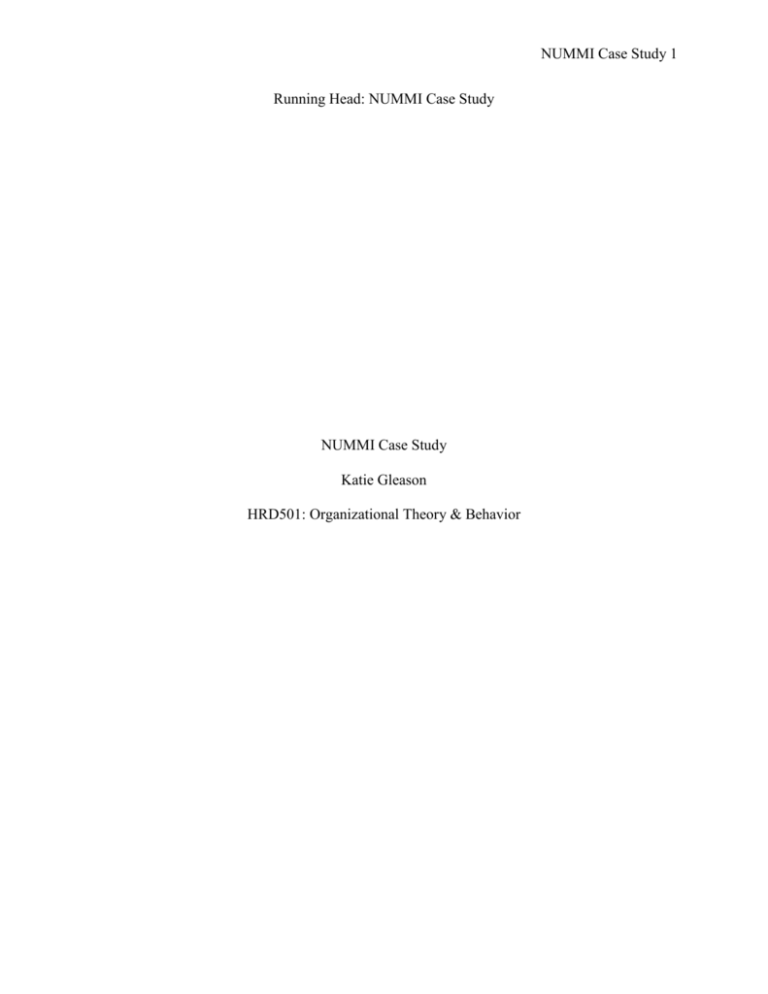
NUMMI Case Study 1
Running Head: NUMMI Case Study
NUMMI Case Study
Katie Gleason
HRD501: Organizational Theory & Behavior
NUMMI Case Study 2
The joint venture between GM and Toyota, called New United Motor Manufacturing,
Inc. (NUMMI) began officially in 1984. This venture was the result of poor performance from
the GM Fremont manufacturing plant and Toyota’s wish to learn more about building cars in the
United States and dealing with U.S. suppliers. After much negotiation, GM contributed its
Fremont plant and Toyota contributed the capital and the way of life (Adler, 1993).
By creating this new company (initially for the purposes of creating the “new” Chevy
Nova) GM and Toyota created a whole new corporate culture in American car manufacturing.
They took a plant that had closed due to poor performance and completely turned it around. The
employees of NUMMI, most of which were the old employees from the Fremont plant, now had
a place of work in which they could take pride and feel as though they truly contributed. This
new attitude was due to the freedom and respect given to the employees from the beginning of
the venture. The employees were treated from the start as adult individuals with ideas and
experiences, which in turn lead to more satisfied and productive workers (Adler, 1993).
The new company culture at NUMMI included an environment where worker ideas were
welcomed and more often than not, listened to. Employees did not feel as though a suggestion or
complaint would be cause for termination because of the no-layoff clause in the Collective
Bargaining Agreement with the United Auto Workers (UAW) (Adler, 1993, p. 102). This
increased level of job security for employees allowed them the freedom to say what they needed
to. The respect they received allowed them to behave as adults when they spoke out and offered
ideas.
Employee’s ideas were requested to help maintain the production system. The
management philosophy was, from the start, more of a guidance philosophy. Although the work
on the production system was standardized, employees were developing and maintaining the
NUMMI Case Study 3
methods. Engineers were no longer standing above them telling them what they should be able to
accomplish. Employees were taught the additional knowledge necessary to monitor and make
changes to the production system to keep it optimal, which in turn granted the employees a sense
of power (Adler, 1993, p. 103). By empowering the employees to make changes to a system they
use constantly, the workplace became a more effective place to work.
NUMMI began the venture by hiring most of the GM Fremont employees who had been
laid off. The selection process was fairly standard, including interviews and pre-employment
testing with their applications (Adler, 1993, p. 99). Keeping the application process standard, as
well as the testing and simulations that were required, was a benefit to the selection process as it
creates a level playing field for all possible employees. It creates an environment where all are
equal and so the final hiring decision is based on actual qualifications. Using both managers and
union officials to choose employees creates a level of trust and a feeling of openness from the
start. Teamwork is emphasized and enforced from the top down.
Following up the selection process with an excellent socialization process is essential to
the success of any organization. Employees entering a new work environment tend to be anxious
about what awaits (Kanouse, 1980, p. 36). All employees have an adjustment period as they are
learning the new company, and according to Chao et al. (1994), “Organizational socialization
plays a central role in the adjustment and learning process of employees” (p. 730). By providing
a solid socialization process, the organization provides the first stepping stone for success and
helps reduce anxiety about new responsibilities. Chao et al. (1994) continue to state:
Although job performance is also related to issues not directly tied to organizational
socialization (e.g., training programs, previous experience, education, etc.), the
identification of what needs to be learned and how well an individual masters the
NUMMI Case Study 4
required knowledge, skills and abilities can be directly influenced by the socialization
process. (p.731)
Welcoming each employee individually during this socialization process helps employees
realize they are viewed as individuals instead of numbers. This is important to the people on a
psychological level, as Roethlisberger (1941) states:
Whether or not a person is going to give his services whole-heartedly to a group depends,
in good part, on the way he feels about his job, his fellow workers, and supervisors – the
meaning for him of what is happening around him. (p. 143)
Employees need to know that their opinions count. Beginning the socialization process by
personalizing everyone creates the impression in the employees’ mind that they are important.
NUMMI management made a difficult choice when hiring the old GM-Fremont
employees. Some would argue against hiring former employees based on the statistics that came
from GM-Fremont. However, Adler (1993) states that “GM was afraid of a union backlash at
other plants if it tried to set up the joint venture as a nonunion shop” (p. 99). While fear of
consequences should not be what a decision is based on, it was good business to consider the
morale of the other shops. Another salient point to consider is that by hiring the workers who had
been laid off, the work pool has experience being unemployed. This experience would provide
incentive to perform better, as most of those people would not want to experience the same
situation again.
Initially I would not have suggested hiring the old employees – this is a gut reaction not
based on facts or any substantial research. Delving deeper into the case, and also into the ideas of
Roethlisberger (1941), Chao (1994), and Maslow (1943), hiring the former GM-Fremont
employees, including the union hierarchy, is actually a very smart business decision.
NUMMI Case Study 5
Roethlisberger (1941) found that employees essentially want to be listened to (p. 144). This will
make them happier. Chao (1994) found people who are better socialized are more satisfied and
involved with their careers, in addition to being more adaptable and having a better sense of
personal identity (p. 741). Maslow (1943) found that individuals have basic needs which must be
met, starting with physiological needs (p. 149). These physiological needs can only be met if
there is the ability to provide for them, which the job at NUMMI begins to be able to do. Maslow
(1943) also recognizes the esteem needs (p. 151) which state that people need to be recognized
and held with respect. By providing the employees with respect and treating them as equals,
NUMMI management meets another of Maslow’s basic needs. By meeting these needs and
providing the old employees with the tools and incentives to be better workers, the organization
created a better workforce than it would have been able to hire new.
A benefit of having the old GM-Fremont workers at NUMMI is their experience with the
way things used to be. At GM-Fremont, the factory was arranged on a more traditional Taylorist
method. Engineers evaluated and created methods which the managers were supposed to enforce
and the employees were supposed to follow. This method did not work well. When NUMMI
opened its doors, it approached Taylor’s views from a different angle. The management teams at
NUMMI took Taylor’s basic principles and humanized them (Adler, 1993).
It was recognized that there is one best way for accomplishing a task – the NUMMI spin
on this is to let the employee who has to accomplish the task design the best way to accomplish
it. Providing the employees with the education to design the task is only a small step in the new
process. Allowing the workers to develop the best procedures empowers the employee and gets
them more involved in the job. They become more willing to do what they need to because they
NUMMI Case Study 6
have determined that they are accomplishing the task in the best way possible. With every team
member involved in the design process, every person becomes more committed to the end result.
The employees already went through a rigid application process to become part of the
team and are given the education to be able to match well with the job at hand. Cross-training all
employees allows for better job matches to be made when necessary, as well. The team
environment of NUMMI promotes cooperation. Including management levels on teams ensures
that there is a voice from management as well as the extra experience level available when
necessary. Because the traditional power structure has been abolished at NUMMI, management
is already working closely with the employees – this ensures management’s input on the task
design as well as a fair share of task work.
The “Taylorist” principles are applied every place they can be in the NUMMI plant, and
applied effectively. Allowing the employee input is crucial to the success and does not
countermand the Taylorist approach because of the training the employees receive. The
employee essentially becomes the engineer sitting in the little observation room, only he’s on the
floor and able to make logical, sound decisions based on experience and knowledge.
This interpretation of Taylor’s principles can be used in other organizations if they use
NUMMI as a model. The key to NUMMI’s success is the respect and trust given to the
employees. To try to implement this version of Taylorism without giving the employees the
respect and trust they deserve would be setting an organization up for failure.
The employees are in an admittedly bureaucratic structure. They have management levels
and are in a union environment. The type of work they do, basic assembly line work, requires
standard procedures to maintain quality and quantity. To counteract the idea that bureaucracy
and standardization are bad for the company, NUMMI places a very strong emphasis on
NUMMI Case Study 7
workplace learning and continuous improvement (kaizen). This emphasis enables the employees
to feel as though they are not in such a rigid environment.
The NUMMI project began with an emphasis on learning by sending the management
teams to Japan, then having them return to the U.S. to train the remaining employees. The
organization arranged management as such that the upper level managers are on an equal level
with the rest of the employees as far as dress and special privileges. The organization also places
an emphasis on management’s role in the company. Management is to be a support to the
employee and is seen as the place to go when expert knowledge is needed (Adler, 1993).
Employees look to management when a problem arises that they cannot find an answer to or
when it is time to learn something new to fix a current issue.
A key point in the kaizen philosophy of NUMMI is cross-training. Adler (1993) states
that “workers are cross-trained in all team assignments and then allowed to shift from one task to
another” (p. 102). Having all employees’ cross-trained opens up communication channels and
allows more ideas to come to the surface. It also provides variety to the employees in what could
be a mundane job. By making sure that everyone is cross-trained, options are available to the
company when sales are low or when an employee leaves or has an emergency. When
opportunities arise, such as in 1988 when sales were low, the company took advantage of this
and employees who were no longer needed on the production floor were sent to training classes
instead of being laid off (Adler, 1993).
Another benefit of having everyone cross-trained is the reciprocal relationship between
standardization and learning. All employees learn all aspects of the job, which means that the
employees are now knowledgeable and experts in their own place. This enables them to monitor
their position and make changes when something goes wrong. While the standard procedures are
NUMMI Case Study 8
in place to maintain quality and quantity, the employees have the power to improve the standard
process because they have the knowledge and ability (from learning) to make adjustments.
Providing a standard structure enables the employee to become an expert in their field, which in
turn gives the employee the opportunity to apply their knowledge at their workstation and create
better and more positive standards for the company. Employees are invested in their positions
instead of simply being there to complete a process. This level of employee involvement, defined
by Robbins and Judge (2007) as “a participative process that uses the input of employees to
increase their commitment to the organization’s success” (p. 97), is very high at NUMMI. This
empowers the employee to make a difference in their work environment.
NUMMI provides an excellent model of employee empowerment. The traditional power
relationships have been abolished in the NUMMI work environment and the first step towards
this was implementing the clothing/uniform requirement and eliminating the special privileges
for management. By putting everyone on a visual level of equal footing, it makes the technical
divisions less obvious and removes overt power levels. Adler (1993) states “middle management
layers are layers of expertise, not of rights to command, and if middle managers have authority,
it is the authority of experience, mastery, and the capacity to coach” (p. 107). Removing the
traditional power structure allows power to be gained by those with experience who have earned
the respect of the rest of the work force. This benefits the company as “research suggests pretty
clearly that the personal sources of power are most effective” (Robbins & Judge, 2007, p. 200).
The next step that NUMMI makes for its employees is providing them with the
knowledge, abilities and authority to make decisions regarding the production system. NUMMI
offers its employees respect and trust and indicates this, for example, by allowing them their own
accounts for supply orders (Adler, 1993, p.106). Workers realize that they have “positive power
NUMMI Case Study 9
to improve quality and efficiency” and “negative power to disrupt production” (Adler, 1993, p.
107). There is a balance at the plant that keeps the entire system functioning, however. The
environment of continuous learning, trust and respect that has been developed creates loyalty and
a source of motivation for the employees. Because they are being treated with respect and as
adults, the employees are more motivated to create excellent product and maintain a good work
record.
Prior to reading about NUMMI and through personal experience dealing with my own
staff, I had learned that if you showed people respect and trust while allowing them as much
flexibility and autonomy as possible, they tended to be more productive and loyal. Empowering
the employee in the workplace is extremely important because employees are adults who wish to
be treated as such. Ideas and thoughts should be valued and taken into consideration when
coming from the person who completes a job day in and day out. Employees should be
empowered – chances are they will work happier, longer and better. Learning about NUMMI has
only cemented these views more firmly in my mind. Seeing the same techniques and views
implemented on such a large scale with the excellent results that NUMMI ended with proves that
empowering the employee can truly make the organization a better place to work while
increasing the bottom line.
In conclusion, NUMMI seems to be the perfect synergy of Japanese work practices and
American technology. Pairing the two with the commitment levels and management support that
was given and received from everyone involved created a conducive environment for the
successful interpretation of Taylor’s scientific management ideas as well as continuous learning
culture. Removing the traditional power structure of corporate culture and replacing it with a
structure which empowers the employees creates an ideal work environment where people can
NUMMI Case Study 10
feel valued and feel as though they are respected. The NUMMI example can be transferred to
other companies that are willing to invest the time and effort into their people. It would be
amazing to see all of the corporations of America focus on their people using NUMMI’s model
of business – chances are their bottom lines would increase as well as employee satisfaction!
NUMMI Case Study 11
References
Adler, P. S. (1993). Time-and-Motion Regained. (Harvard Business Review Reprint 93101).
Boston, MA: Harvard College, Harvard Business School Publishing.
Chao, G., O’Leary-Kelly, A., Wolf, S., & Klein, H. (1994, October). Organizational
socialization: Its content and consequences. Journal of Applied Psychology. 79(5), 730743. Retrieved September 17, 2007, from PsycARTICLES database.
Internet Center for Management and Business Administration, Inc. (2007). Frederick Taylor &
Scientific Management. Retrieved November 1, 2007, from
http://www.netmba.com/mgmt/scientific/
Kanouse, D., & Warihay, P. (1980, July). A new look at employee orientation. Training &
Development Journal, 34(7), 34. Retrieved September 17, 2007, from Academic Search
Premier database.
Maslow, A. H. (1943). A Theory of Human Motivation. In J. S. Ott., S. J. Parkes, & R. B.
Simpson (Eds.), Classic Readings in Organizational Behavior (5th ed.) (pp. 148-157).
Belmont, CA: Wadsworth.
Robbins, S. P. & Judge, T. A. (2007). Essentials of Organizational Behavior. (9th ed.). Upper
Saddle River, New Jersey: Pearson/Prentice Hall.
NUMMI Case Study 12
Roethlisberger, F. (1941). The Hawthorne Experiments. In J. S. Ott., S. J. Parkes, & R. B.
Simpson (Eds.), Classic Readings in Organizational Behavior (5th ed.) (pp. 140-147).
Belmont, CA: Wadsworth.

